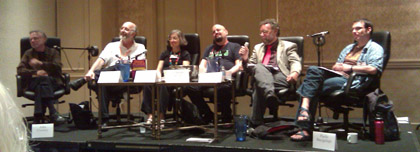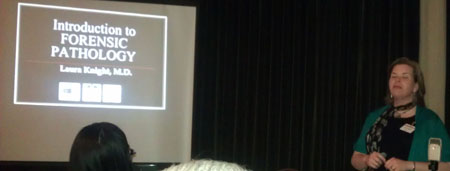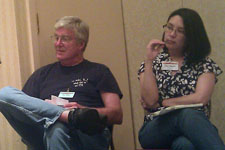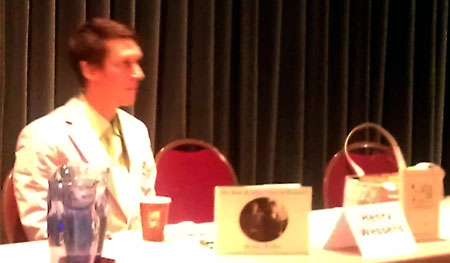11 a.m. The New and Improved Future of Magazines (Part 2)
Panelists: John Joseph Adams, Sean Wallace, Robert Killheffer (Leader), John Benson, and Leah Bobet.
Panel Description: After last year’s “The Future of Magazines” panels, participant K. Tempest Bradford wrote: “The magazines and anthologies that I love tend to have editors who have taken the time to examine themselves or their culture, to expend their knowledge of other people and ways of being, to open their minds. These magazines and anthologies contain far more stories I want to read by authors of many varied backgrounds. As I said, it’s not fully about print vs. online, it’s about better magazines and books.” This time, creators and proponents of both print and online magazines collaborate on determining ways that any genre magazine can create a brighter and better-read future for itself, using Bradford’s comment as a launching point.
This first part of this panel was on print media only and was last year. This year they were discussing print and online media. Things had changed so much that online was now a growing area for magazines
Leah Bobet championed the need to use the online media or internet as it should be used and do more stories in hypertext and other newer narrative arts.
Narrative tends to be linear using the page after page top to bottom print magazine structure. The nature of the internet allows for different art forms but as magazines have moved to the digital format and online they’ve retained the linear narrative form we’re all used to.
John Bensen talked about how things continue to cycle. Once the radio had stories. A reader would read a complete story or novel on the radio. Now we have podcasts which essentially are stories that are read to us. The difference is that it’s digital and the listener can not only choose the time they listen to it (rather than being limited to the radio program schedule) but can download the story, book, or program they want to hear.
There was a discussion of how important accessibility is for the materials you’re putting up. Print is fine but if it can’t be found by a reader it’s not accessible. The internet is much more accessible to people since it’s available worldwide and many people can find it with a google search. Magazines are sometimes print, online, and available in several different formats for ereaders and as podcasts. Thus accessible to a number of users no matter how they want to access it.
All mentioned that receiving email or electronic submissions make their jobs much easier. It’s easier to format. They can respond quicker. And putting a magazine together is also easier when you collect the electronic documents.
Bobet mentioned Anthology Builder where you look through the stories available and pull them together to be the anthology that you want to read. It used print-on-demand technology.
Noon Travel Literature
Panelists: James L. Cambias, Michael Dirda, Howard Waldrop, Fred Lerner (Leader), and Debra Doyle.
Panel Description: The link between genre fiction and travel literature is one of honorable standing: even discounting obvious crossovers like Gulliver’s Travels or Lucian of Samosata’s True History (arguably the earliest work of science fiction), what is The Left Hand of Darkness if not a travelogue of Gethen, or why are maps of Middle-Earth included in every edition of The Lord of the Rings? Ursula K. Le Guin’s Changing Planes reads like a Baedeker of the next universe over, but our sense of wonder and desire for a different world might be as easily satisfied by Bill Bryson in Australia, Jan Morris in Italy, or Charles Dickens in America. Should it be? Panelists and attendees are invited to discuss the pleasures and perils of travel literature, starting with their favorites.
The panel differentiated between guide books and travel books. Guide books tell you about the place in rather clinical detail. Travel books are a more personal experience with a place and its people.
Mentioned that at the turn of the century just about every American who crossed the Rio Grade wrote a travel book about their experience. These books seemed to see travel as a lark. However, they also seemed to see the place they traveled to as being there only for their entertainment and amusement.
Dirda mentioned his liking those travel books by the young, sandy-haired British gentleman who goes off to travel a foreign land. These also tend to be travel as a lark. Examples of this type of writing: T.E. Lawrence’s writings while he traveled with his father; Mo Willems’ You Can Never Find a Rickshow when it Monsoons: The World on One Cartoon a Day; John L. Stephen’s Incidents of Travel in the Yucatan and other Incidents of Travel books mostly dealing with South America; The Travels of John Mandeville The Fantastic 14th Century Account of a Journey to the East; most of Jules Verne’s work is travelogue – Around the World in 80 Days; Charles M. Doughty’s Travels in Arabia Deserta; Well’s War of the Worlds in a very good travelogue of the home counties as Wells bicycled all over taking notes before writing the scenes; Kipling’s Kim and Heinlein’s Citizen of the Galaxy; H.P. Lovecraft since you could draw a map of Arkham from reading his stories and the descriptions of the place; Italo Calvino’s Invisible Cities, though one panelist thought it was more prose poems; Lucian’s True Histories, these are real tall tales.
Many of Kiplings techniques of travel writing are used by SF writers – just say something and don’t explain it. SF is travel to place you can’t go or don’t exist but you must make it real.

2:00 p.m. Everybody Loves Dirigibles: Science for Tomorrow’s Fiction.
Panelists: Paolo Bacigalupi, John Crowley, Jeff Hecht (Leader), Joan Slonczewski, Charles Stross, Michael Swanwick.
Panel Description: According to William Gibson, “We can’t spin futures, because the present has become too brief.” By the time the fiction is written, the science has moved on: “Nothing gets quainter faster than that history you just made up.” But is there really only a synaptic gap’s width between cutting-edge and outmoded? It’s taken decades for viruses to come up to competition with radiation as the biomedical handwave of choice; the prominence of airships in the popular imagination remains undaunted by the fact that the zeppelin hasn’t been cutting-edge since 1932. And who’s writing the great novel of the Large Hadron Collider? Our panelists compare the current state of the scientific field with the fiction it’s inspiring—or should be. What ideas endure beyond the obsolescence of their science? What latest developments remain unexplored?
(This is by Hyperion) Despite the fact the dirigibles were in the title, the panel was technically more about how technology passes you by while you’re busy writing your story. And despite this fact, a good 25% of the panel was about dirigibles. Why? Because everybody loves them. There is something about certain technologies that just won’t let them die in our imaginations, no matter how hard governments and corporations insist on ignoring them. Dirigibles haven’t been financially viable as transport since the 1930s. Charles Stross mentioned that it wasn’t really the design of the Hindenburg that caused the disaster. Well, unless you count the fact that they used rocket propellant to seal the hull. It was the US embargo on exporting helium that did it in. If it had had the helium buffer it was supposed to have, the accident probably wouldn’t have happened.
Other dirigible related information dealt with local lifters, which move very heavy items that helicopters either can’t handle, or if they can, can’t operate in residential areas. One of the more interesting bits concerned the, now defunct, CargoLifter company from Germany. When they went bankrupt, a consortium of Eastern businessmen bought up their hanger. The hanger is so large that they’ve turned it into a tropical resort 30 miles east of Berlin. Inside is artificial seashore, complete with sand beach, and a rainforest. They actually have balloon tours of the inside of the hanger. Finally it seems that the final doom for dirigibles is simply speed. They don’t move fast enough for our modern age. Joan naturally pointed out that the bacteria which can be used to generate vast amounts of hydrogen in an economical manner, actually they reproduce extremely quickly. But nobody gives bacteria any respect.
Other than dirigibles, nuclear power was a favorite topic. Nuclear powered space probes, nuclear powered airplanes; which had the unfortunate side effect of killing the passengers because they couldn’t afford the weight of the shielding, and nuclear powered trains (well, electric trains powered by nuclear power). The first is still on the drawing boards, the latter is thankfully long ago abandoned, and the last is in France. The anecdotes surrounding these technologies which once formed the backbone of the future as foretold by science fiction fans showed an anticipation of permanence. And in fact, most of the technologies have endured, although only in niche environments, or mutated nearly out of recognition. There was a time when every car had a cigarette lighter. They still exist, although you can’t light a cigarette anymore. Instead they’ve become the ubiquitous power source for running your cellphone, laptops, and GPS systems.
All in all, a good time was had by all, good questions were asked, good answers (although sometime drifting sharply off topic) were provided, and lots of good information on a wide range of beloved technology was given. Now I’m still waiting for my flying car. And has anybody seen my jetpack?
5:00 p.m. Interview with Nalo Hopkinson. Interviewer was Jim Freund.
I always find the Guest of Honor Interviews interesting and this one was certainly no exception. Freund ask some questions and Nalo regaled us with stories of her father who was a Latin and English teacher as well as a Shakespearian actor. She mentioned that among the people of the Caribbean she’s known as her father’s daughter rather than a writer/author.
Hopkinson is a Clarion graduate attending the workshop in 1985. She said she went feeling that she had nothing to say. She could put words together but didn’t know what to say with those words.
She mentioned that when she writes a short story, she can sense the shape and trajectory but when writing a novel it’s like seeing an oncoming train through thick fog. (a very useful analog to my mind)
They talked about her work reading stories on CBC (the Canadian equivalent of NPR), the anthologies that she edited and her novels. She mentioned working on Mojo: Conjure Stories how after she accepted a few of the stories, she could see the shape of the anthology and the rest of the stories were taken with that shape in mind. When she realized that, she thought those rejection notes that say, “Sorry but this does not meet our needs at this time,” just might be the truth.
She’s funny, sincere, committed to writing the best work she can and in being honest in her writing which she says is very scary. But what helps is seeing how open Chet Delany is and he’s still there doing okay.
All in all, it was an interesting chance to listen to a writer I admire talking about her life and her writing.
After the interview, we closed our table in the Dealer’s Room for the day and sought dinner. We’re now back in our room and have decided to call it a night. Readercon is always fun but I’m just coming off a pretty bad fibro flare and I’m exhausted and we still have Sunday to get through. The Dealer’s Room closes at 2 and we’ll leave shortly after that. Then we have a 10 hour drive home not counting the detour to Providence, RI to visit my son for a few hours on the way home — haven’t seen him since Christmas.









